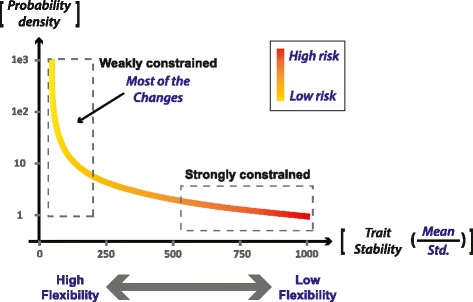Fig. 1.

Putative distribution of (trait) flexibility and deleterious potential (risk level). The probability density curve corresponds to the density of traits (y-axis) at a given level of stability (x-axis). The flexibility of a trait (1/Trait Stability) is represented by the standard deviation, divided by the mean (Std./Mean), both computed over time in a single individual. The expected density of traits is an increasing function of trait flexibility and a decreasing function of the trait’s deleterious potential (risk level). We also expect a wide range of flexibility values, illustrated in this example by a (scale-free) power-law increase of the density as a function of trait flexibility. The inverse correlation between the flexibility of a trait and its deleterious potential is represented by a color code, with red (‘high risk’) and yellow (‘low risk’) associated, respectively, with high and low probabilities for a detrimental outcome of a change in the respective trait
